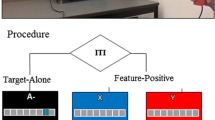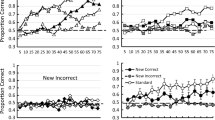Abstract
This experiment was conducted with the objective of demonstrating that the effective stimuli in Pavlovian Conditioning are not environmental stimuli but internal physiological processes elicited by environmental input (proximal stimuli). In order to achieve the objective, afterimages in color vision were used: looking at a diffuse lightened circle after seeing a red circle yields an image of a green circle. A differential conditioning paradigm with two sequential compounds was run. In one group (G+B−: n1=10), a red circle followed by a green circle was paired with shock, whereas a red circle followed by a blue circle remained unpaired. A second group (G−B+: n2=10) received red-blue paired trials and unpaired red-green trials. Immediately after that training, subjects were tested with a new, never trained sequential compound: a red circle followed by a diffuse lightened circle. Furthermore, they were tested with the already trained compounds. Taking the environmental point of view, the never trained stimulus should elicit an orienting response lying inbetween the excitatory reaction to the paired stimulus and the inhibitory reaction to the unpaired stimulus. From the proximal point of view, the diffuse light should elicit an excitatory reaction in group G+B− and an inhibitory reaction in group G−B+. Electrodermal conditioned anticipatory and omission responses were measured. The results supported the proximal hypothesis. Hence, defining input in environmental terms may be the wrong way. Instead, in conceptualizing the stimulus in conditioning, the following should be considered: the processing organism itself is creating the effective stimuli.
Similar content being viewed by others
References
De Valois, R. L., and De Valois, K. K. Neural coding of color. In E. C. Carterette and M. P. Friedman (Eds.),Handbook of Perception. Vol. V. New York: Academic Press, 1975.
Gibson, J. J. The concept of the stimulus in psychology.American Psychologist, 1960,15, 694–703.
Koffka, K.Principles of Gestalt Psychology. New York: Harcourt, Brace, 1935.
Lykken, D. T. Range correction applied to heart rate and GSR data.Psychophysiology, 1972,4, 437–442.
Lykken, D. T., and Venables, P. H. Direct measurement of skin conductance: A proposal for standardization.Psychophysiology, 1971,8, 656–672.
Miller, N. E., and Dollard, J.Social Learning and Imitation. New Haven, CT: Yale University Press, 1941.
Pavlov, I. P.Conditioned Reflexes. (Trans. by G. V. Anrep). London: Oxford University Press, 1927.
Prokasy, G. F., and Kumpfer, K. L. Classical conditioning. In W. F. Prokasy and D. C. Raskin (Eds.),Electrodermal Activity in Psychological Research. New York: Academic Press, 1973, 157–202.
Skinner, B. F.The Behavior of Organisms. New York: Appleton-Century-Crofts, 1938.
Spence, K. W.Behavior Theory and Conditioning. New Haven: Yale University Press, 1956.
Stern, J. A., and Walrath, L. C. Orienting response and conditioning of electrodermal responses.Psychophysiology, 1977,14, 334–342.
Venables, P. H., and Christie, M. J. Electrodermal activity. In I. Martin and P. H. Venables (Eds.),Techniques in Psychophysiology Chichester: Wiley, 1980, 4–67.
Author information
Authors and Affiliations
Rights and permissions
About this article
Cite this article
Lachnit, H., Bohn, A. Pavlovian conditioning with proximal stimuli. Pav. J. Biol. Sci. 21, 156–159 (1986). https://doi.org/10.1007/BF02734514
Issue Date:
DOI: https://doi.org/10.1007/BF02734514




